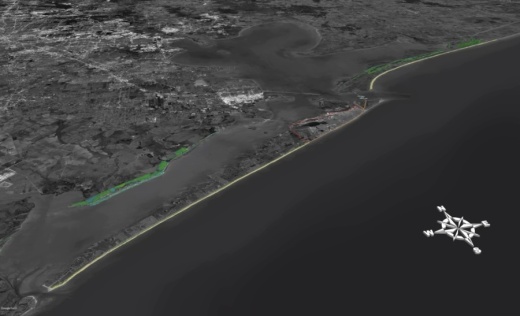But already, some officials are thinking ahead, coming up with ways to potentially fund the multibillion-dollar project.
If approved as is, the coastal barrier, designed by the U.S. Army Corps of Engineers and Texas General Land Office, would include a system of navigable gates, walls and man-made islands between Galveston Island and Bolivar Peninsula. The gates would remain open to allow ships to pass but would close in the event of a major storm to block storm surge coming into the bay and potentially flooding communities, Morgan’s Point Mayor Michael Bechtel told League City City Council during a Nov. 10 workshop.
“This is where all the big bucks are going to, ... but they work,” he said. “Everybody’s pretty much on board with this.”
The existing 10-mile seawall along Galveston Island would be improved with increased height and other enhancements. An 18-mile ring barrier system would be built around Galveston Island to protect neighborhoods and businesses, according to the study’s website, www.coastalstudy.texas.gov.
About 43 miles of beaches and sets of parallel dunes would be constructed to protect other parts of the coast in a natural way. Bechtel said the dunes, at the proposed heights of 12 feet and 14 feet, would not withstand even a tropical storm, let alone a hurricane, and has proposed they be raised to a minimum height of 17 feet, he told council.
The Corps has touted a $26 billion-$32 billion price tag for the entire project.
“Total B.S.,” Bechtel told the council. “Half of that $32 billion is on environmental projects that environmentalists have never been able to get funding for.”
Bechtel said that in reality, the gates, walls, beaches and dunes without attached environmental work would cost $10 billion-$12 billion.
“That’s still a hell of a lot of money,” he said.
Texas can seek federal funding, in which case the state would have to front 35% of the project. Even at the low end for the estimated project cost, that is still a $3.5 billion tab for Texas, Bechtel said.
There is another method to get funding, however, Bechtel said. The idea is to use resilience bonds to fund the project, which would be basically the same as funding the project with insurance savings.
By building the coastal barrier system, all the businesses and homes in the “risk pool” from hurricanes and storms would avoid an estimated $3 billion worth of losses annually. It is possible to use resilience bonds to take money from the increased values and insurance savings and reimburse investors that fund the project that results in the savings, Bechtel said.
The question is what method the state would use to collect and disperse those monies to the investors. A taxing authority is possible, but there are other ways. Officials need to come up with a plan before Texas’s legislative session begins in January, Bechtel said.
Residents have until Dec. 14 to submit comments on the Corps’ proposed coastal barrier plan. To submit comments on the project, email [email protected]; call 409-766-3004; or mail to Attn: Mr. Jeff Pinsky, Environmental Compliance Branch, Regional Planning and Environmental Center, P.O. Box 1229, Galveston, TX 77553-1229.
Public virtual meetings on the project will be held Nov. 16, 11 a.m.-1 p.m. and 6-8 p.m.; Dec. 3, 11 a.m.-1 p.m. and 6-8 p.m.; and Dec. 8, 11 a.m.-1 p.m. and 6-8 p.m. A virtual question and answer session on the project will be held Dec. 2, 6-8 p.m.
For meeting details, visit www.coastalstudy.texas.gov/get-involved/public-meetings/index.html.





